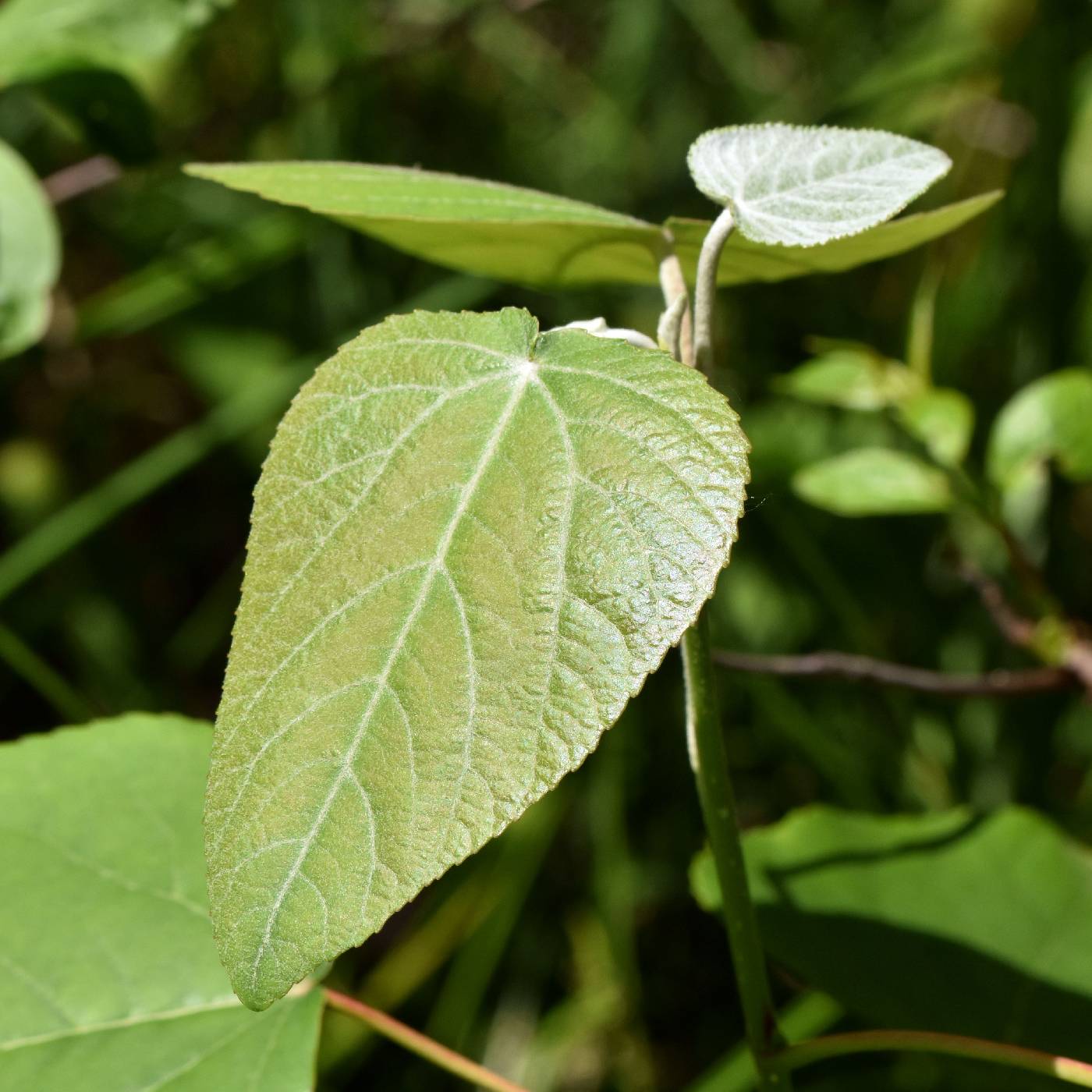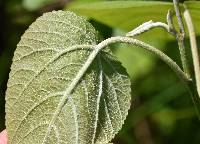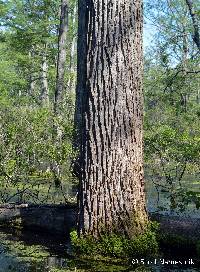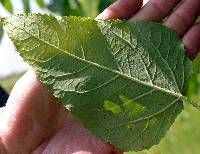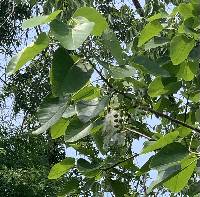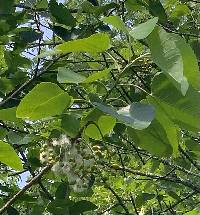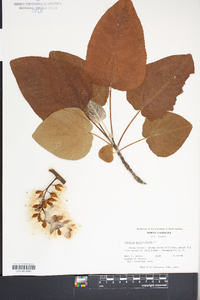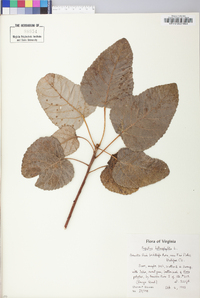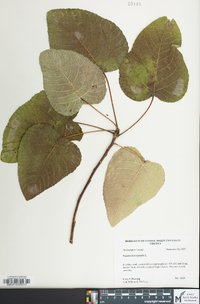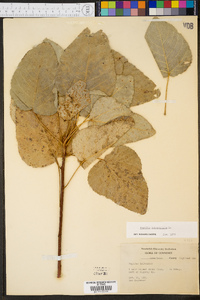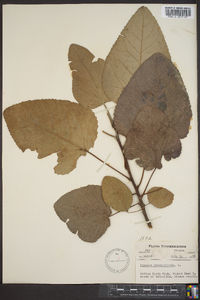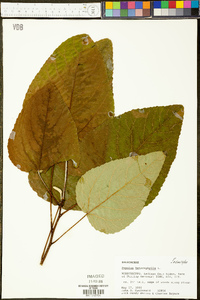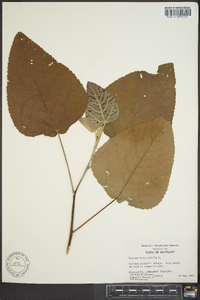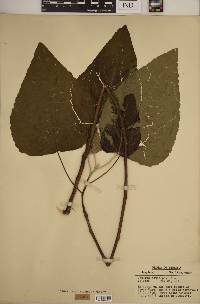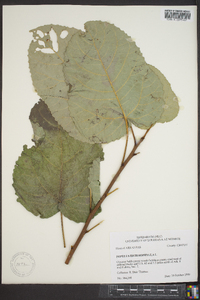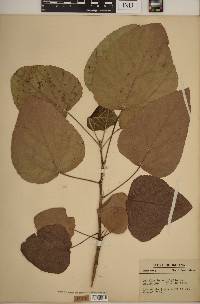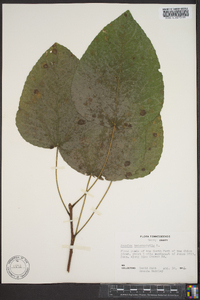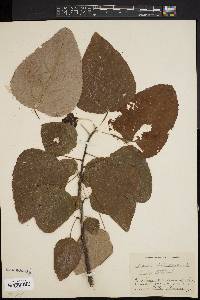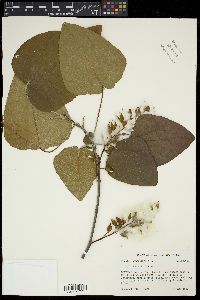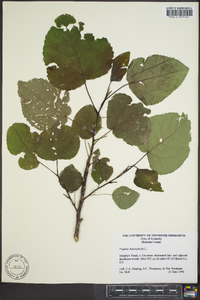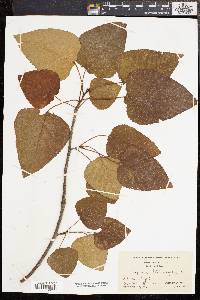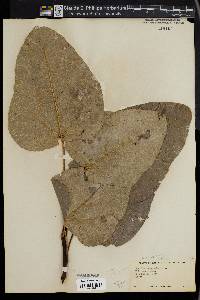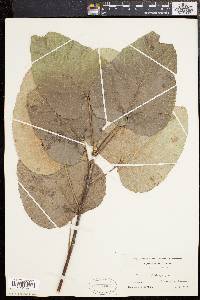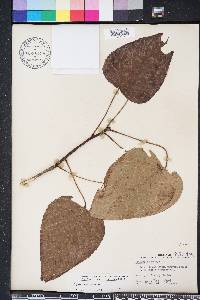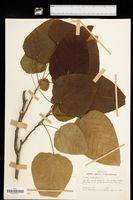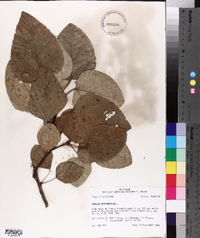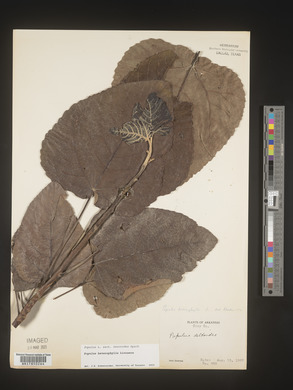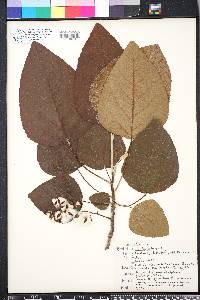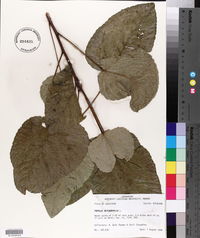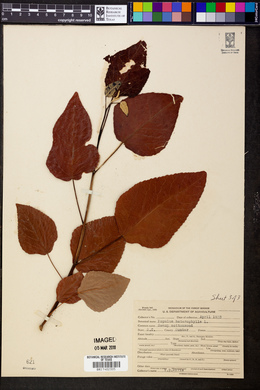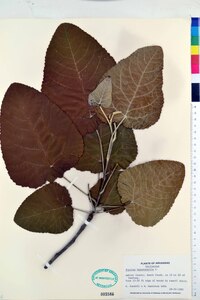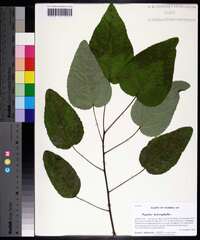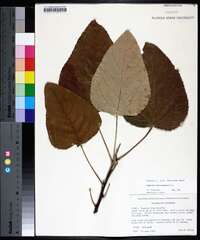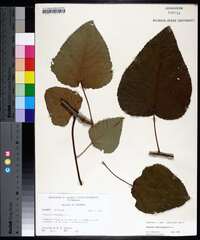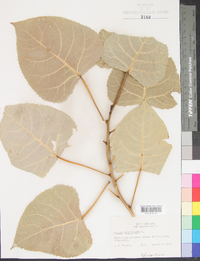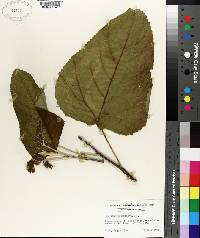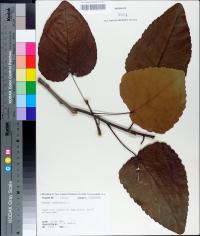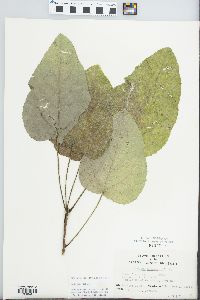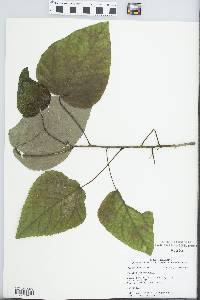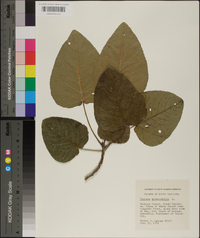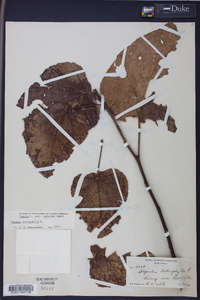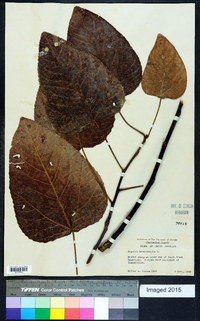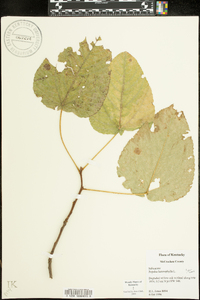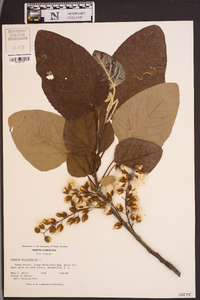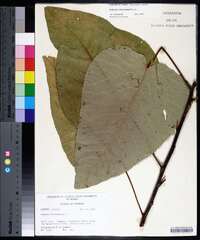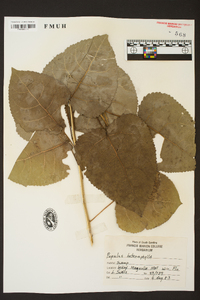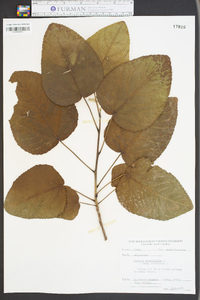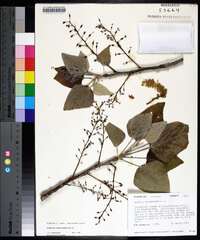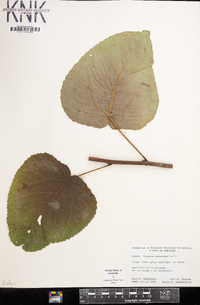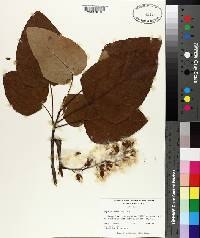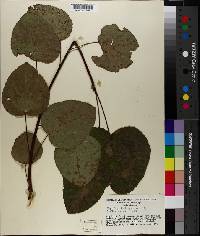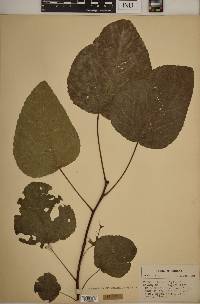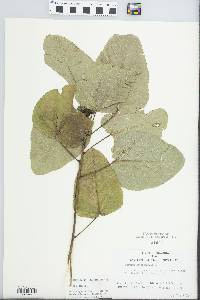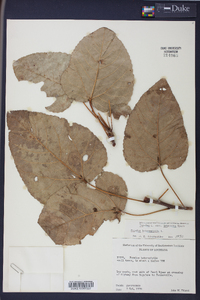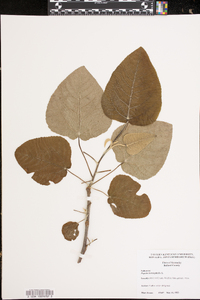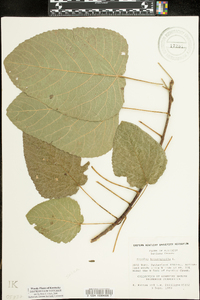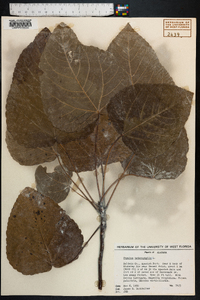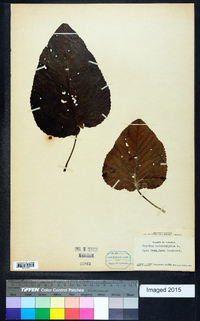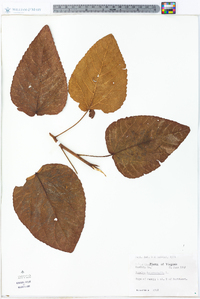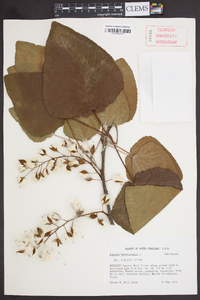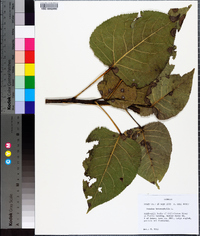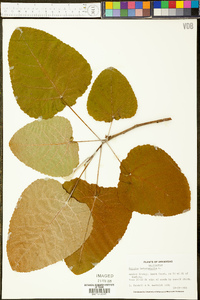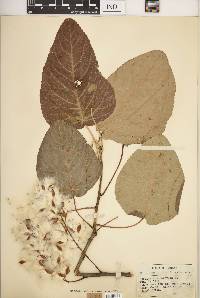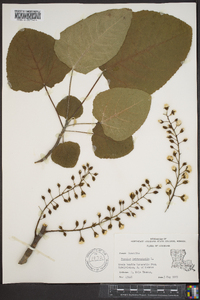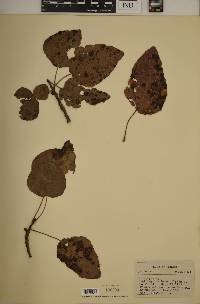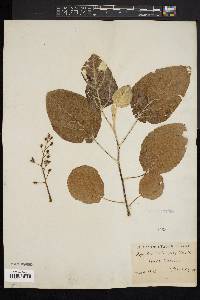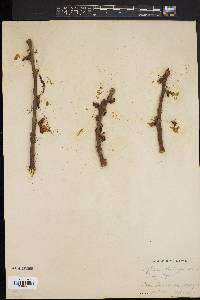
|
|
|
|
Family: Salicaceae
Swamp Cottonwood
|
Plants to 28 m, 12 dm diam.; not obviously heterophyllous. Bark reddish brown to brownish gray, deeply furrowed. Branchlets reddish brown, becoming grayish by third year, round to 5-angled, 3-6 mm diam., very coarse, thinly tomentose to glabrate. Winter buds reddish brown, pubescent, slightly resinous; terminal buds 4-7 mm; flowering buds separated on branchlets, 4-7 mm. Leaves: petiole round distally, (1-) 4-8(-12) cm, 1/2 blade length, (tomentose to glabrate); blade ovate, (3.5-)9-20(-24) × (3.5-)7.5-12.5(-19) cm, w/l = 2/3-3/4, base deeply cordate to subsagittate, basilaminar glands 0 or 2, round, margins not translucent, not ciliate, apex obtuse to apiculate, abaxial surface pale green, pubescent to partly glabrate, retaining tomentum at least basally and on midvein, adaxial dark green, glabrous; preformed and neoformed blade margins finely and unevenly crenate-serrate throughout, teeth 30-60 on each side, sinuses 0.3-1 mm deep. Catkins sparsely 10-15(-45)-flowered, 4.5-8(-18 in fruit) cm; floral bract apex deeply cut, not ciliate (pubescent abaxially). Pedicels (1-)5-10(-18 in fruit) mm. Flowers: discs (caducous), cup-shaped, not obviously oblique, toothed, 1.5-2.5(-4) mm diam.; stamens 15-35; anthers apiculate; ovary 3-carpelled, ovoid to spherical; stigmas 2-4, convoluted, expanded, erect. Capsules ovoid, 8-14 mm, glabrous, 3-valved. Seeds 6-9 per placenta. Flowering Apr; fruiting May-Jun. Nyssa-Taxodium swamps, drainage ditches, natural and artificial wet depressions, coastal plains, central lowlands, piedmont along major streams; 0-200(-400) m; Ont.; Ala., Ark., Conn., Del., D.C., Fla., Ga., Ill., Ind., Ky., La., Md., Mich., Miss., Mo., N.J., N.Y., N.C., Ohio, S.C., Tenn., Va. Populus heterophylla is widespread and uncommon in most of its range, which is entirely included within that of P. deltoides. Reports of swamp poplars from upland habitats are based on misidentified sucker shoots of P. grandidentata. Hybrids of P. heterophylla and P. deltoides are found in disturbed habitats, such as drainage ditches. Hybrids have glabrous leaves more elongate than those of P. deltoides.
Medium-sized to large tree 12 - 27 m tall, trunk diameter 30 cm - 0.6 m Leaves: alternate, on 6 - 10 cm long, sometimes sparsely hairy leafstalks, green above, paler beneath, 8 - 25 cm long, 6 - 20 cm wide, broadly egg-shaped with a rounded or heart-shaped base and rounded or bluntly pointed tip, blunt-toothed, densely white-woolly when young, becoming hairless with age (undersides may remain hairy, especially along major veins). Flowers: either male or female, borne on separate trees (dioecious) in hairy-bracted, stiff catkins. Male catkin long-stalked, 3 - 10 cm long, thick. Anthers red. Female catkin long-stalked, few-flowered, 3 - 15 cm long, and slender. Fruit: a two- to three-valved capsule, borne in 6 - 15 cm long drooping catkins, reddish brown, and egg-shaped. Seeds light brown with cottony hairs attached. Bark: gray or yellowish brown, thin, and smooth on young trees, becoming light brown and furrowed with scaly ridges. Twigs: stout, brown or gray, sometimes hairy, lenticels prominent, surface layer peeling or flaking (except on current year's growth). Leaf scars triangular, with three bundle scars each. Pith orange and star-shaped in cross-section. Buds: reddish brown, egg-shaped, pointed, and resinous. Terminal bud 1.5 - 2 cm long. Form: cylindrical to irregular, with a few large, upright branches. Similar species: The similar Populus balsamifera differs by having bluntly pointed leaves with woolly undersides (especially along the major veins). Flowering: April to May, before the leaves Habitat and ecology: Typical of swamps and low woods. It is very rare in the Chicago Region, but can be found in the swampy woodlands of the Kankakee River valley. In 1989 it was discovered at the Momence wetlands in Kankakee County, growing in a backwater area where there is standing water much of the year. Occurence in the Chicago region: native Notes: The wood of Populus heterophylla is used for pulp, fuel, and interior finishing. Populus species as a whole are subject to many diseases and insect pests, such as canker and tent caterpillars, which often kill the tree or make it unattractive. These risks, in conjunction with a water-hungry root system, have made Populus species less desirable for landscape use. Etymology: Populus is the Latin word for poplar. Heterophylla means "diversely leaved." Author: The Morton Arboretum Tall tree, with shaggy, dull brown bark; buds usually ±pubescent, not or scarcely glutinous; petioles terete, or slightly flattened only near the summit; lvs broadly ovate, 12-20 cm, obtuse or rounded, finely crenate-serrate with incurved teeth, cordate at base, tomentose when young, becoming glabrous above except at the very base of the blade, glabrous below except along the larger veins; scales of the catkins long-ciliate; stamens 12-20; stigmas 2 or 3, broadly dilated, each on a conspicuous style; frs ovoid, 2-3-valved, 7-12 mm, on pedicels 10-15 mm, forming a loose raceme. Wet low woods and swamps; sw. Conn. to Fla. and La., n. in the interior to s. Mich. Gleason, Henry A. & Cronquist, Arthur J. 1991. Manual of vascular plants of northeastern United States and adjacent Canada. lxxv + 910 pp. ©The New York Botanical Garden. All rights reserved. Used by permission. From Flora of Indiana (1940) by Charles C. Deam In Indiana it is infrequent in the lake area, local in the central part, local to frequent in the southern part, and possibly absent in the southeastern part. It becomes a tall, slender tree, 10-16 inches in diameter. It grows on the borders of ponds in woodlands which have for a subsoil a stiff blue clay, locally called "gumbo." The habitat simulates that of pin oak but I do not recall ever seeing these species growing together. It is usually associated with red maple, sweet gum, and cypress. Where there are more than a few trees it is usually found in a pure stand. It is most abundant in the sloughs of the Lower Wabash Bottoms. …… Indiana Coefficient of Conservatism: C = 8 Wetland Indicator Status: OBL Deam (1932): The pith of the shoots of this species is orange which easily distinguishes it from all other species of the genus which have a white pith. This species in all of its range is closely associated with the common cottonwood. |
|
|
|

